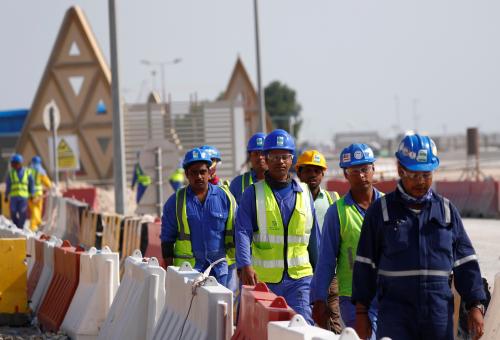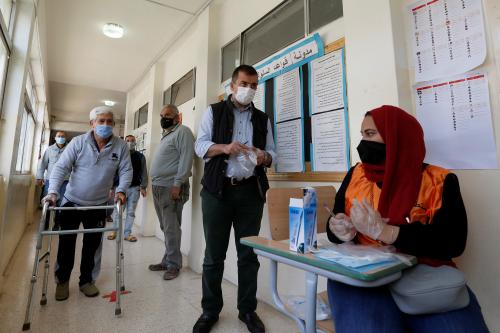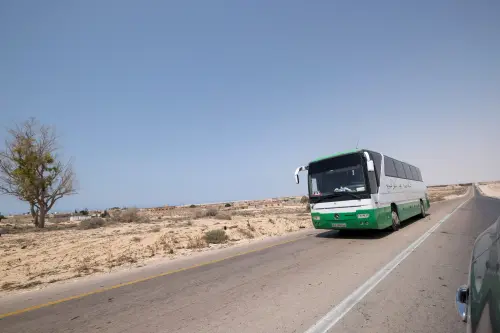Content from the Brookings Doha Center is now archived. In September 2021, after 14 years of impactful partnership, Brookings and the Brookings Doha Center announced that they were ending their affiliation. The Brookings Doha Center is now the Middle East Council on Global Affairs, a separate public policy institution based in Qatar.
“There is no animosity between the authorities and the Islamist current. The brothers in Sinai know this…and the [Rafah] operation in this frame makes no sense. It is a criminal act and we all condemn it,” said Magdi Salem, one of the leaders of what was known once as al-Jihad Organization of Egypt. Salem, along with three others, arrived in the Sinai on a mission last week: to limit the scope of the conflict and isolate the perpetrators of the August 5 Rafah massacre, in which an armed group killed 16 Egyptian border guards and then infiltrated Israel. Why are the Post-Jihadists in the sensitive and turbulent Sinai environment? In fact, this is not the first interaction between Salafi-Jihadists and Post-Jihadists in that geo-strategically sensitive and marginalized peninsula, and it certainly won’t be the last.
The uneasy dalliance between the Egyptian state and the jihadists over the Sinai dates back to the Taba and Nuweiba simultaneous bombings in October 2004. After that disaster, the State Security Investigations (SSI) and the Central Security Forces (CSF) had almost no information about the perpetrators and therefore conducted a brutal crackdown in North Sinai. They arrested around 3,000 people, and took women and children related to suspects hostage until the suspects surrendered. One of the detainees from 2004 reported, “they electrocuted us in the genitals for a day or so before asking any questions. Then the torture continues during and after the interrogations. Many of the young-men swore revenge.”
A second wave of bombings hit Sharm el-Sheikh in July 2005. This time, an organization declared responsibility for the attacks. Al-Tawhid wa al-Jihad (TJS), Monotheism and Struggle, in Sinai was inspired by Abu Musab al-Zaraqawi’s organization in Iraq, but most of its leaders and members were locals. The founder, Khaled Musa‘id, was a dentist from al-Arish City and a member of al-Swaraka tribe, one of the largest and most influential in North Sinai. Musa‘id was killed in a fire-fight with the CSF on September 28, 2005. Despite his death, his main contribution was transforming an ideological current in books and speeches into a real organizational structure, with a hierarchy and multiple cells in at least five cities or regions (al-Arish, Rafah, al-Isma‘iliya, Central Sinai/Halal Mountain, and Nakhla).
The offshoots of TJS went in different directions. All of them attracted new, like-minded groups and individuals. The largest faction became content with preaching Salafism and locally engaging in Salafi-style social work. This included arbitrating disputes on sharia basis and providing a range of social services. This is represented by the Ahl al-Sunna wa al-Jama‘a (ASJ) Salafi Society, the Legitimate Committee for Conflict Resolution in North Sinai (LCCR), and around five other smaller organizations. Another offshoot was more content with paramilitary training without engaging in any armed activities, whether in Egypt or against Israel. And a third offshoot did both the stockpiling and the training and then engaged in a series of armed operations, mainly against Israeli targets. Among those is Majlis Shura al-Mujahidin fi Aknaf Bayt al-Maqdis (Consultative Council of Holy Strivers Near Jerusalem), which declared its responsibility for attacking a military post in Kissufim in northwestern Negev desert with two Grad missiles.
After the 2005 bombings a second wave of arrests and crackdowns ensued. Many suspected TJS members and sympathizers as well as their relatives, acquaintances, and neighbors were arrested. “We met them in prison. Most of them did not know anything about ideology, theology, or jurisprudence. Some were illiterate and we had to teach them how to read,” said a former Islamist detainee who was imprisoned with the “Sinai group,” as they were known. “All what the actual TJS members have studied were three booklets written by Abu Muhammad al-Maqdisi [famous Jordanian Jihadist ideologue] and this led them to go wide on takfir [excommunication of the ‘other’].”
The Sinai detainees were mainly distributed in five prisons: Damanhur, Highly Guarded (known as The Scorpion), Liman Torah, New Valley, and Natrun Valley. Most of the interactions between them and the Post-Jihadists took place in those prisons between 2004 and 2009. The Islamic Group (IG), several former al-Jihad leaders, and independent, Salafi figures gave them lessons in Islamic jurisprudence (fiqh), creed (‘aqida) and the revisions produced by the IG and others. In prisons, some of the TJS members abandoned the core belief of Jihadism: that armed action is the sole theologically legitimate, instrumentally effective method for social and political change. One was led by Sheikh Hamadin Abu Faisal, the current head of the ASJ Salafi Society and allegedly one of the former TJS commanders. He spent 18 months in detention following the Taba bombing. “I owe the Sheikhs [in prison] for many things … but I am really worried about the return of the old days,” he said. By “the old days” he meant a brutal crackdown, part of it related to Operation Eagle (al-Nisr), a military-security sweep that resulted in the arrest of more than a 100 suspects and the killing of more than 11 (including the alleged leader of the Rafah operation). Some of the old practices showed up in al-Nisr, including alleged revenge arrests and settling old scores between security officers, tribal leaders, and Islamists. But the vindicated suspects were released much quicker compared to the times of the Hosni Mubarak dictatorship — days instead of decades.
The worries of Abu Faisal and the volatile situation in Sinai sparked several recent initiatives by Salafis and Post-Jihadists. The IG has developed quite a comprehensive strategy to deal with the situation, submitting it to the defense and interior ministries as well as the presidency. “We are awaiting their reply and we are ready to help in any way we can,” said Tariq al-Zumur, the spokesperson of the IG and the head of the political bureau of its party, Construction and Development.
But the perception of some of the IG leaders is controversial mainly because of the revisions and the “de-radicalization” process. “Those guys [specific leaders were named] signed the revisions and supported it. They are considered ‘snitches’ by many jihadists,” stated a former detainee from Sinai. Indeed, for many Egyptian and Arab Salafi-Jihadists, the fault-line between loyalty and betrayal is the stance on the revisions. Despite its major results in the 2000s, in the 2010s the processes of de-radicalization — as endearing to moderates — limits, and sometimes kills, the influence of the ones associated with it over any armed Islamist organization.
Al-Nour Party, the political wing of the Salafi Call in Alexandria took another initiative. Although they have a history of rivalry with the Jihadi current, al-Nour initiated a three-day lecture series of what can be termed as “Counter-Jihadism” and “Counter-Takfirism” events. Several Salafi figures and parties are intending to do the same. But their role will be limited to prevention, as opposed to mediation, due to the history and the ideological differences.
Mohammed al-Zawahiri is a more credible mediator for the Sinai Jihadists, but not for other parties. He also is preparing an initiative. A more generic one that goes beyond Sinai, the 13-point initiative proposes “mediation” between the various groups that belong to the Jihadi current and the “West.” The objective of the “mediation” is to cease armed operations against Western targets and even to protect western citizens and interests, in exchange for releasing Jihadist prisoners in the West, and the withdrawal of western military personnel from Muslim-majority states. In its current form, the initiative is more likely to attract media attention on the September 11 anniversary, and less likely to convince decision-makers and develop into a serious mediation attempt.
On a local level, Sinai’s Post-Jihadist and Salafi-Jihadist figures have established a local conflict resolution committee: the Legitimate Committee for Conflict Resolution in North Sinai (LCCR). The LCCR has been successful in arbitrating tribal disputes on Islamic sharia basis rather than the usual tribal norms. It has been the focal point of the aforementioned initiatives and efforts to ceasefire. But the LCCR has its own problems as well. “Everybody here has a weapon. Now the army arrests anyone with a beard and a weapon,” says a local LCCR arbiter in al-Arish. “Sheikh Amin Abu Talha the coordinator of LCCR in Sheikh Zuwaid was arrested … he used his weapon to guard al-Arish Church during the revolution … now the media liars are calling him a terrorist who has been a fugitive for five years. They are smearing us,” he said. Abu Faisal agreed and elaborated on other dimensions of the crisis: “Why is the media coming to us? … they should go after the drug barons, the state security torturers, and the remnants of Mubarak’s regime for answers.”
The current crisis in Sinai is with tens of armed Jihadists, not with hundreds and certainly not with thousands. If it is not quickly contained or eliminated, it can become worse in terms of scope, scale, and intensity. But any of the models of armed organizations on volatile borders, like that of Hezbollah (full state-sponsorship), Lashkar-e-Taiba (partial state-sponsorship), or Chechen Mujahidin groups in Pankisi Gorge (limited state authorities) are not likely to develop. For the containment of the situation in Sinai, however, a centralized local leadership body, comprehensive disarmament, demobilization, and reintegration program (DDR) and a structured method of interaction with Salafists and Post-Jihadists to legitimate the transitions and limit armed dissent will be required.
Over the longer term, the Sinai Peninsula should not be dealt with as merely a potential geo-strategic security threat for Cairo. The policies and standard operating procedures based on such assumption should be revised and altered under President Mohamed Morsi. The sweeping crackdowns; discrimination against, and humiliation of, the local population; hostage-taking by security services; torture; and degrading treatment of the locals were practiced in Sinai, with long lasting repercussions even after the revolution. Similar policies were applied in Upper-Egypt throughout the 1990s and they had disastrous consequences, ending with the Luxor massacre of November 1997 and a long list of local vendettas.
In the last six decades, Sinai has been a decisive factor in Egypt’s high politics: from the rise of Gamal Abdel Nasser as the new Arab leader in 1956 until the removal of Field-Marshal Hussein Tantawi and his generals of the Supreme Council of the Armed Forces (SCAF) in 2012. It will remain so in both Egyptian and regional politics in the foreseen future. Under the first elected civilian president of Egypt, it is time to break the vicious cycle of the ad-hoc, reactive, repression-intensive tactics and begin the implementation of a comprehensive policy toward the Sinai that addresses both the short-term and mid-term security threats (with very specific features and targets including defining the threat, its nature, its supportive conditions, and the legitimate counter-tactics and counter-strategies). Additionally, any comprehensive policy should also address the long term developmental needs of the region, including the tribal, socio-economic, political, identity, and demographic dimensions of the problem as well as conflict resolution and conflict prevention strategies and alternatives.



Commentary
Op-edJihadists and Post-Jihadists in the Sinai
September 5, 2012